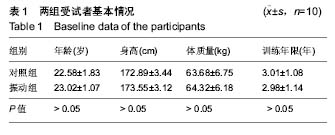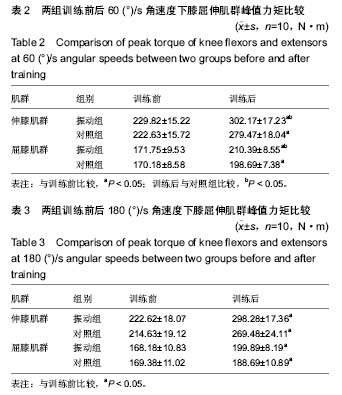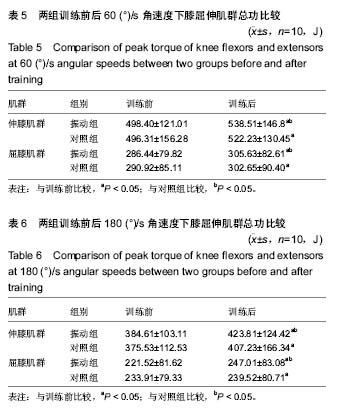中国组织工程研究 ›› 2019, Vol. 23 ›› Issue (15): 2327-2331.doi: 10.3969/j.issn.2095-4344.1152
• 肌肉肌腱韧带组织构建 tissue construction of the muscle, tendon and ligament • 上一篇 下一篇
振动训练足球运动者膝关节屈伸肌群肌肉的力量
余 宏,刘 琰
- (中国民用航空飞行学院,四川省广汉市 618307)
Strength of knee flexor and extensor in football athletes after vibration training
Yu Hong, Liu Yan
- (Civil Aviation Flight University of China, Guanghan 618307, Sichuan Province, China)
摘要:
文章快速阅读:
.jpg) 文题释义:
振动训练:作为一种新兴的肌肉力量训练方法,在国外众多领域得到广泛开展。振动训练区别于其他力量训练方法的最大特点是能够以相对较小的附加负荷有效地提高肌肉的最大力量、快速力量及力量耐力。Bosco的研究表明,振动训练后即刻就可检测到肌肉收缩功率的明显提高。
肌力:是指肢体作随意运动时肌肉收缩的力量。检查方法是嘱患者上下肢依次作各关节伸、屈运动,并克服检查者所给的阻力,观察肌力是否正常、减退或瘫痪,并注意瘫痪部位。一般上肢作上臂的外展、内收、前臂伸屈、腕的伸屈、手指的外展、内收、握拳;下肢作屈髋、小腿伸屈,足跖及背屈等。在病情需要时,尚需对有关的每个肌肉进行分别检查。
文题释义:
振动训练:作为一种新兴的肌肉力量训练方法,在国外众多领域得到广泛开展。振动训练区别于其他力量训练方法的最大特点是能够以相对较小的附加负荷有效地提高肌肉的最大力量、快速力量及力量耐力。Bosco的研究表明,振动训练后即刻就可检测到肌肉收缩功率的明显提高。
肌力:是指肢体作随意运动时肌肉收缩的力量。检查方法是嘱患者上下肢依次作各关节伸、屈运动,并克服检查者所给的阻力,观察肌力是否正常、减退或瘫痪,并注意瘫痪部位。一般上肢作上臂的外展、内收、前臂伸屈、腕的伸屈、手指的外展、内收、握拳;下肢作屈髋、小腿伸屈,足跖及背屈等。在病情需要时,尚需对有关的每个肌肉进行分别检查。
.jpg) 文题释义:
振动训练:作为一种新兴的肌肉力量训练方法,在国外众多领域得到广泛开展。振动训练区别于其他力量训练方法的最大特点是能够以相对较小的附加负荷有效地提高肌肉的最大力量、快速力量及力量耐力。Bosco的研究表明,振动训练后即刻就可检测到肌肉收缩功率的明显提高。
肌力:是指肢体作随意运动时肌肉收缩的力量。检查方法是嘱患者上下肢依次作各关节伸、屈运动,并克服检查者所给的阻力,观察肌力是否正常、减退或瘫痪,并注意瘫痪部位。一般上肢作上臂的外展、内收、前臂伸屈、腕的伸屈、手指的外展、内收、握拳;下肢作屈髋、小腿伸屈,足跖及背屈等。在病情需要时,尚需对有关的每个肌肉进行分别检查。
文题释义:
振动训练:作为一种新兴的肌肉力量训练方法,在国外众多领域得到广泛开展。振动训练区别于其他力量训练方法的最大特点是能够以相对较小的附加负荷有效地提高肌肉的最大力量、快速力量及力量耐力。Bosco的研究表明,振动训练后即刻就可检测到肌肉收缩功率的明显提高。
肌力:是指肢体作随意运动时肌肉收缩的力量。检查方法是嘱患者上下肢依次作各关节伸、屈运动,并克服检查者所给的阻力,观察肌力是否正常、减退或瘫痪,并注意瘫痪部位。一般上肢作上臂的外展、内收、前臂伸屈、腕的伸屈、手指的外展、内收、握拳;下肢作屈髋、小腿伸屈,足跖及背屈等。在病情需要时,尚需对有关的每个肌肉进行分别检查。摘要
背景:振动训练作为一种新兴的肌肉力量训练方法,在国外众多领域得到广泛开展。足球作为下肢引导类运动项目之一,对下肢力量素质提出了更高的要求。
目的:通过对比分析振动训练和传统力量训练对足球运动员膝关节屈伸肌群肌肉力量的作用,探讨振动训练对足球运动员力量训练的意义。
方法:将20名大学生男性足球运动员随机分为2组,每组10人。振动组采用连续8周、30 Hz频率、2 mm振幅的振动训练,对照组采用无振动的传统下肢力量训练。训练前后分别在60 (°)/s和180 (°)/s角速度下对运动员膝关节屈、伸肌群峰力矩、到达峰力矩的时间及总功进行测试。
结果与结论:①训练后2组在60,180 (°)/s角速度下峰值力矩均显著升高(P < 0.05),在60 (°)/s角速度下2组组间比较峰值力矩差异显著(P < 0.05),180 (°)/s角速度下组间峰值力矩比较无显著差异(P > 0.05);②在180 (°)/s角速度下与训练前比较,2组到达峰值力矩时间显著降低(P < 0.05),组间比较无显著差异(P > 0.05);③在60,180 (°)/ s角速度下2组总功训练后显著升高(P < 0.05),振动组屈、伸肌总功显著大于对照组(P < 0.05);④结果说明,采用连续8周、30 Hz频率、2 mm振幅的振动训练方案可有效提高大学生足球运动员膝关节屈、伸肌最大力量、爆发力和肌肉耐力;在提高最大力量和肌肉耐力方面,振动训练优于传统力量训练;在提高肌肉爆发力上,振动训练与传统力量训练相比未见明显优势。
中国组织工程研究杂志出版内容重点:组织构建;骨细胞;软骨细胞;细胞培养;成纤维细胞;血管内皮细胞;骨质疏松;组织工程
ORCID: 0000-0002-2938-7996(余宏)
中图分类号:




.jpg) 文题释义:
振动训练:作为一种新兴的肌肉力量训练方法,在国外众多领域得到广泛开展。振动训练区别于其他力量训练方法的最大特点是能够以相对较小的附加负荷有效地提高肌肉的最大力量、快速力量及力量耐力。Bosco的研究表明,振动训练后即刻就可检测到肌肉收缩功率的明显提高。
肌力:是指肢体作随意运动时肌肉收缩的力量。检查方法是嘱患者上下肢依次作各关节伸、屈运动,并克服检查者所给的阻力,观察肌力是否正常、减退或瘫痪,并注意瘫痪部位。一般上肢作上臂的外展、内收、前臂伸屈、腕的伸屈、手指的外展、内收、握拳;下肢作屈髋、小腿伸屈,足跖及背屈等。在病情需要时,尚需对有关的每个肌肉进行分别检查。
文题释义:
振动训练:作为一种新兴的肌肉力量训练方法,在国外众多领域得到广泛开展。振动训练区别于其他力量训练方法的最大特点是能够以相对较小的附加负荷有效地提高肌肉的最大力量、快速力量及力量耐力。Bosco的研究表明,振动训练后即刻就可检测到肌肉收缩功率的明显提高。
肌力:是指肢体作随意运动时肌肉收缩的力量。检查方法是嘱患者上下肢依次作各关节伸、屈运动,并克服检查者所给的阻力,观察肌力是否正常、减退或瘫痪,并注意瘫痪部位。一般上肢作上臂的外展、内收、前臂伸屈、腕的伸屈、手指的外展、内收、握拳;下肢作屈髋、小腿伸屈,足跖及背屈等。在病情需要时,尚需对有关的每个肌肉进行分别检查。